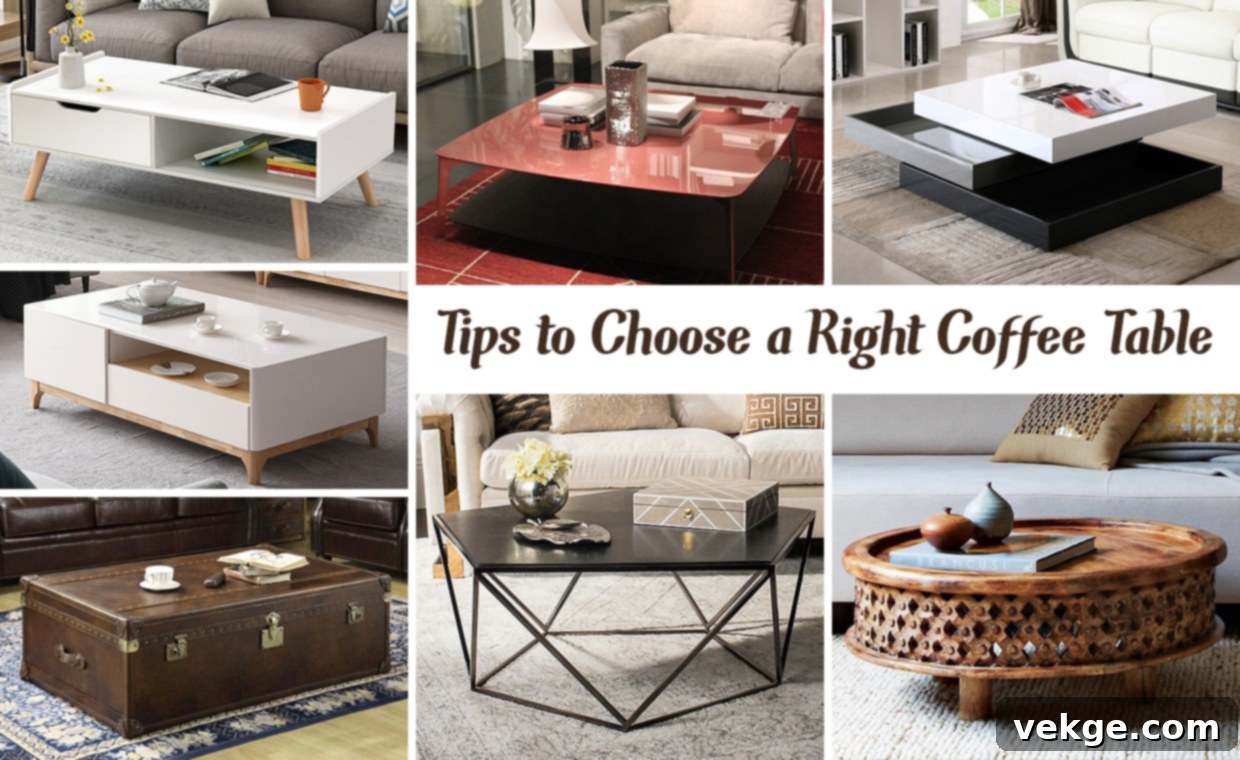The Ultimate Guide to Choosing the Perfect Coffee Table for Your Living Room
The coffee table is more than just a surface for your remote control and beverages; it’s a central anchor in your living room, dictating both the functionality and aesthetic appeal of the space. As a focal point, a well-chosen coffee table can tie an entire room together, reflecting your personal style and enhancing daily living. Conversely, the wrong choice can make your living area feel cluttered, disproportionate, or simply uninviting.
With an endless array of styles, sizes, materials, and shapes available today, finding the perfect coffee table can feel like an overwhelming task. This comprehensive guide is designed to simplify that process, walking you through every essential factor to consider. From understanding crucial dimensions to exploring diverse design trends and practical functionalities, we’ll help you pinpoint the ideal coffee table that not only complements your living room décor but also perfectly suits your unique needs and lifestyle.
Essential Factors to Consider When Buying a Coffee Table
Before you fall in love with a particular design, it’s crucial to consider the fundamental elements that will determine how well a coffee table integrates into your living space. Paying attention to these key factors will ensure your chosen piece is both beautiful and practical.
Coffee Table Size: The Foundation of Function and Flow
Size is paramount when selecting a coffee table. An improperly sized table can either dwarf your seating area or get lost within it, disrupting the room’s balance and flow. To ensure your living room feels harmonious and functional, keep these guidelines in mind:
- Length: As a general rule, your coffee table should be approximately two-thirds the length of your sofa. This proportion creates a visually balanced arrangement, ensuring the table is substantial enough to serve the seating without overwhelming it.
- Height: For optimal comfort and accessibility, the coffee table should be roughly the same height as your sofa’s seat cushions, or perhaps one to two inches lower. This allows for easy reach of drinks, books, or snacks without straining. Tables that are too high can feel intrusive, while those too low might be inconvenient.
- Distance from Sofa: Maintain a clearance of about 18 inches (45 cm) between the edge of your sofa and the coffee table. This gap is ideal for comfortable legroom and allows for easy movement in and out of your seating area. For high-traffic zones, slightly more space might be beneficial.
- Room Scale: Beyond just the sofa, consider the overall scale of your living room. A large, open-concept space might accommodate a more substantial coffee table, or even a grouping of smaller tables, while a compact room will benefit from a more modest or visually lightweight design.
Coffee Table Shape: Defining Your Room’s Personality and Flow
The shape of your coffee table profoundly impacts the room’s aesthetic and how people move through the space. Each shape offers distinct advantages, allowing you to create different focal points and achieve various design objectives:
Rectangular Coffee Table
Rectangular coffee tables are the most classic and versatile choice. Their elongated form provides ample surface area, making them ideal for larger living rooms or for complementing long sofas and sectionals. They are excellent for entertaining, offering plenty of space for drinks, appetizers, and decorative items. Rectangular tables also tend to be more budget-friendly due to their simpler manufacturing process. When decorating, their straight lines can provide a clean, structured look, and they pair well with both traditional and modern aesthetics.

Square Coffee Table
Square coffee tables offer a modern and balanced look, often working exceptionally well with large sectional sofas where a rectangular table might not reach all seating areas. Their clean geometric lines can add a contemporary touch to a room. While they might take up less linear space than a rectangular table, they provide a generous central surface. Square tables are also a smart choice for creating a sense of intimacy and promoting conversation in smaller, more symmetrical living rooms. They can balance out a room with a lot of linear furniture, introducing a strong, deliberate shape.

Round Coffee Table
Round coffee tables are an excellent choice for softening a room with many angular elements, such as sharp-edged sofas or rectangular rugs. Their lack of sharp corners makes them a safer option for households with young children or pets, minimizing the risk of bumps and bruises. Aesthetically, a round table can promote a more relaxed and fluid feel in the living room. They also facilitate easier movement around the table, making them suitable for tighter spaces or rooms with high traffic flow. They offer a classic and elegant appeal that complements various decor styles.
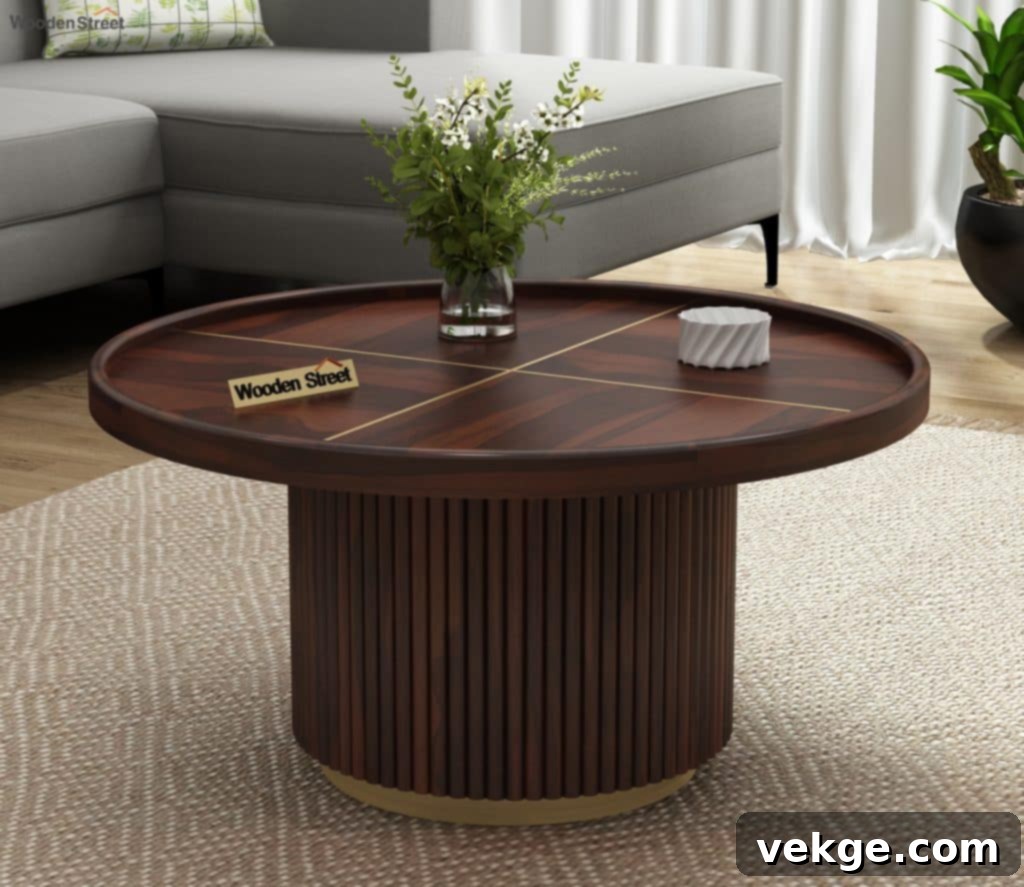
Oval Coffee Table
Oval coffee tables beautifully combine the benefits of both rectangular and round shapes. They offer a generous surface area similar to a rectangular table but with the soft, flowing lines of a round design, eliminating sharp corners. This makes them a great compromise for those who need ample space but also prioritize safety or wish to soften a room’s angularity. Oval tables are particularly suited for narrower living rooms or spaces where a rectangular table might feel too imposing, as their curved edges provide a less bulky appearance and allow for smoother traffic flow. Their sleek, curvy look can complement a wide range of decor styles, from contemporary to transitional.
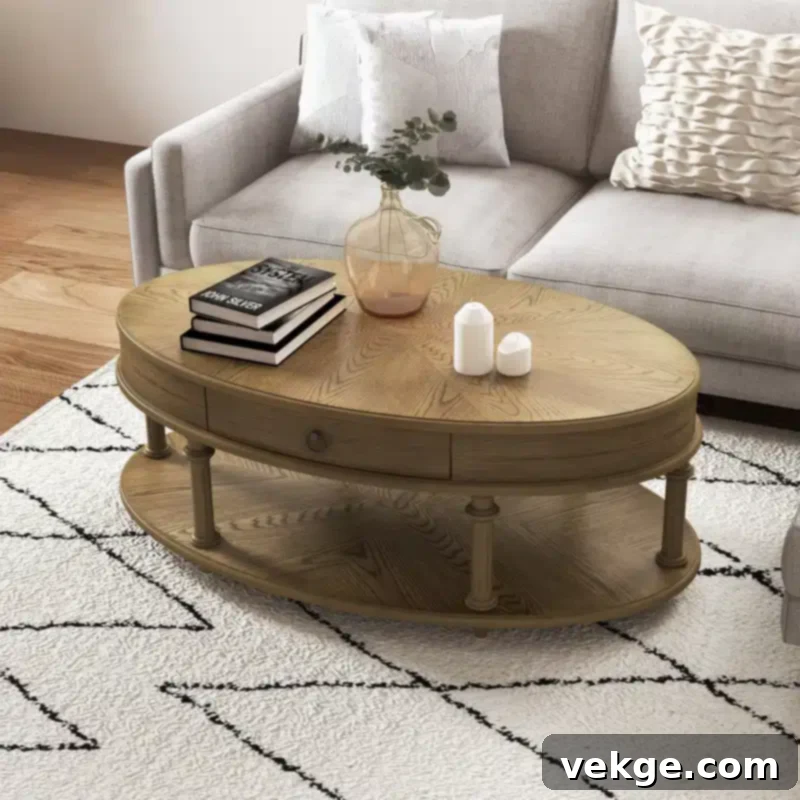
Coffee Table Material: Crafting Your Desired Look and Durability
The material of your coffee table is a crucial element that dictates its durability, maintenance requirements, and overall aesthetic contribution to your living room. Different materials evoke distinct moods and can be used to achieve a vast array of design styles.
Wood Coffee Table
Wood is a timeless and incredibly popular choice, renowned for its natural warmth, versatility, and durability. Whether you prefer the rustic charm of reclaimed wood, the refined elegance of polished dark wood, or the light, airy feel of Scandinavian designs, wood can adapt to virtually any aesthetic. It offers a tactile quality and can be stained or painted to match or contrast with your existing decor. Wood is generally robust and, with proper care, can last for generations, developing a beautiful patina over time. It’s an excellent choice for creating a cozy, inviting atmosphere.
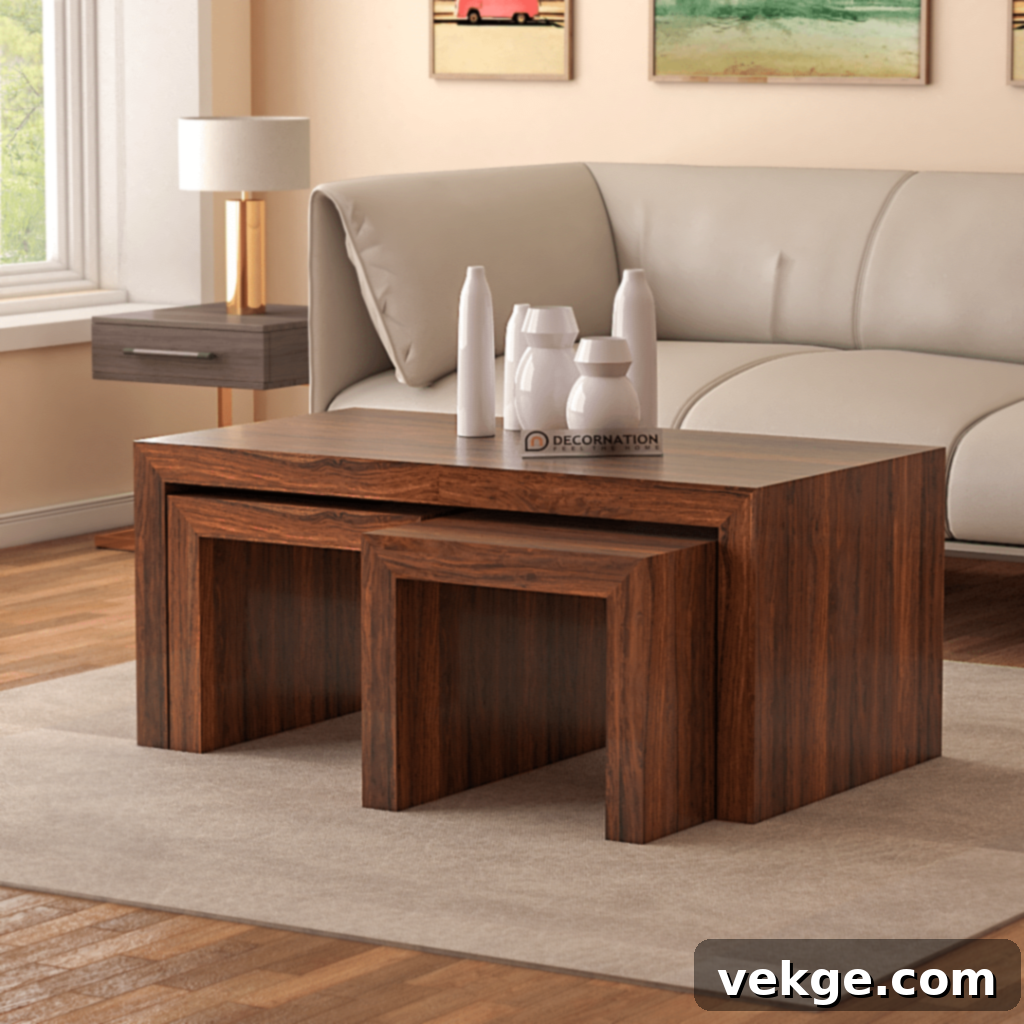
Metal Coffee Table
Metal coffee tables are perfect for achieving a sleek, contemporary, or industrial look. They are incredibly durable, resilient to wear and tear, and often feature minimalist designs. Common metals include steel, iron, brass, and chrome, each offering a different finish and vibe. A polished chrome table can add a touch of glamour, while a matte black iron table can contribute to an edgy, industrial aesthetic. Metal tables are generally low maintenance, easy to clean, and can add a sophisticated contrast when paired with softer fabrics in the room.
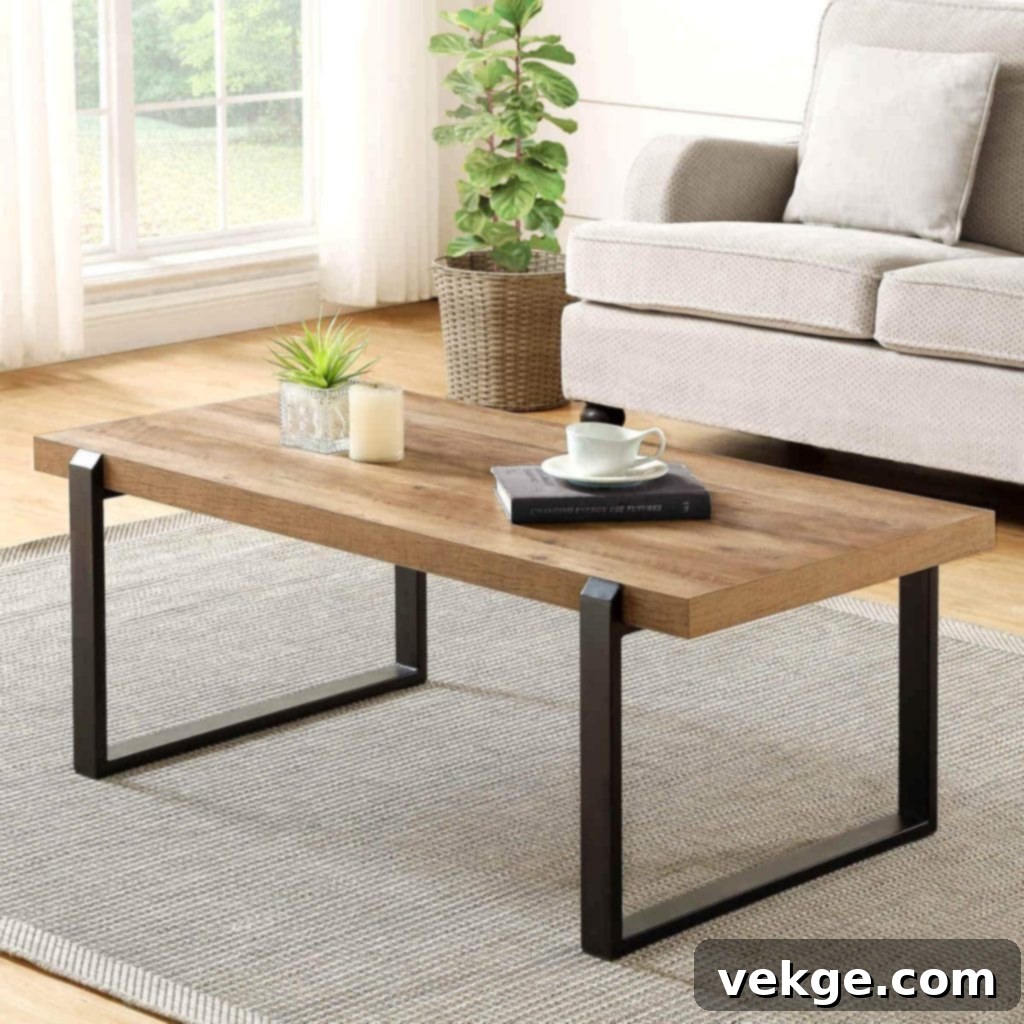
Glass Coffee Table
Glass coffee tables are an excellent choice for adding an immediate touch of elegance and modernity to any living room. Their transparency is a unique advantage, as it allows light to pass through, making small rooms feel larger and more open. This creates a less obtrusive visual footprint, which is invaluable in compact spaces. Glass tables are also very easy to clean and can showcase a beautiful rug or flooring underneath. While generally durable, tempered glass is recommended for safety, especially in homes with active children or pets. They are perfect for achieving a minimalist or glamorous look.

Marble Coffee Table
For an undeniable touch of luxury and sophistication, a marble coffee table is an exceptional choice. Marble is a premium natural stone, known for its distinctive veining patterns, which means no two pieces are ever exactly alike. This makes each marble table a unique work of art, adding an unparalleled level of opulence to your space. While durable and resistant to heat, marble is porous and requires careful maintenance to prevent staining and etching. It’s heavy and stable, making it a substantial focal point. Besides marble, other natural stones like travertine or granite can offer similar upscale aesthetics with varying patterns and color palettes, catering to different design preferences.
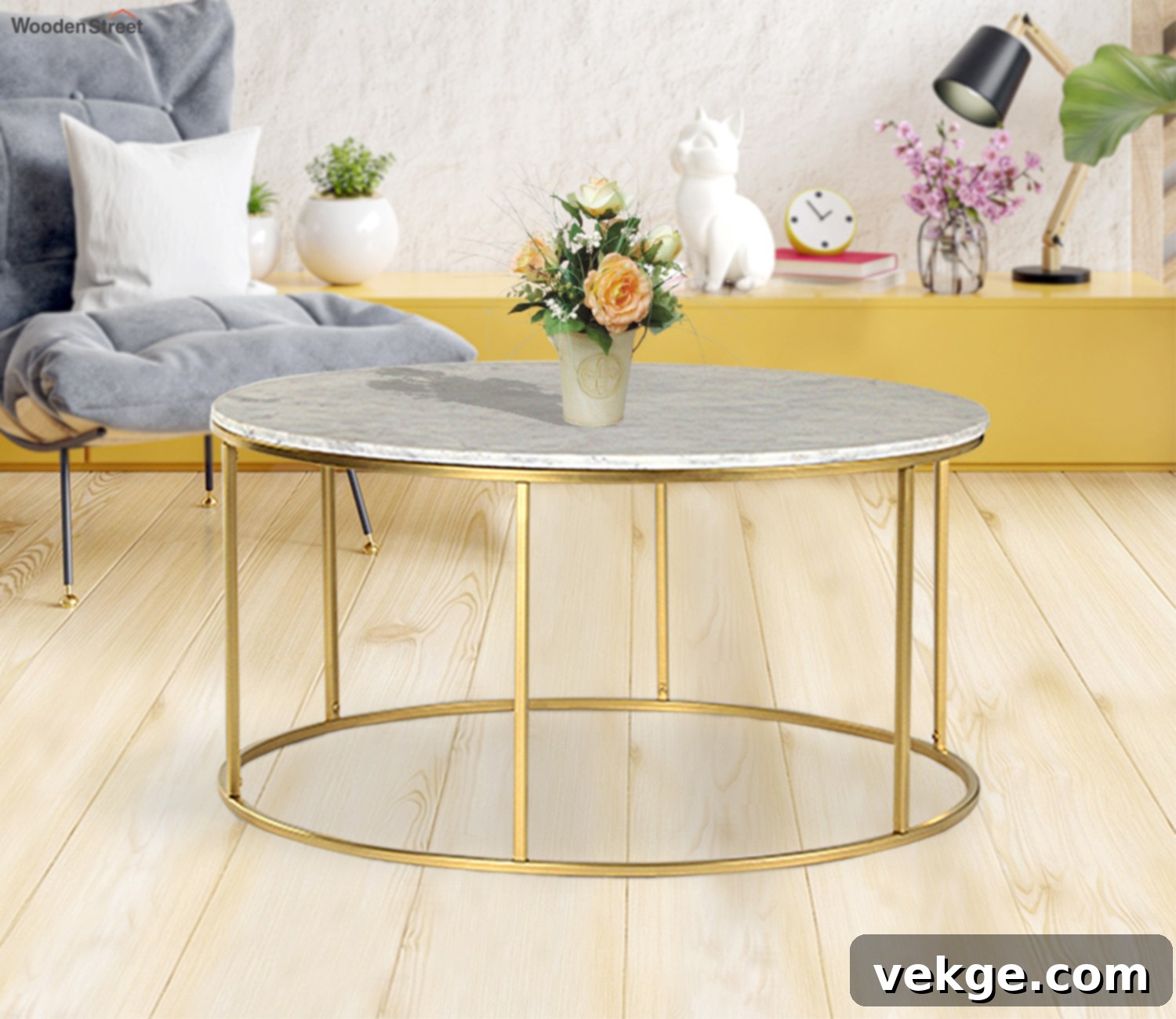
Other Popular Materials:
- Acrylic/Lucite: Transparent and lightweight, acrylic tables are perfect for a minimalist or ultra-modern look, making small spaces appear even larger without adding visual weight. They are surprisingly durable and easy to clean.
- Concrete: For a truly industrial or Brutalist aesthetic, concrete coffee tables offer a raw, robust, and modern statement. They are incredibly durable and can be sealed for easier maintenance, though they are very heavy.
- Upholstered (Ottoman): While also a style, upholstered coffee tables are noteworthy for their material. They offer softness, extra seating, and often hidden storage, making them a comfortable and versatile choice.
Coffee Table Color: Setting the Mood and Complementing Your Palette
The color of your coffee table plays a significant role in establishing the mood of your living room and how it integrates with your existing decor. Color can create harmony or introduce a dramatic contrast, acting as a subtle accent or a bold statement piece.
- Neutral Tones: Shades of white, gray, beige, and natural wood tones offer a timeless and versatile foundation. They are perfect for creating a warm, inviting, or serene atmosphere and seamlessly tie in with other furniture pieces. A light-colored table can brighten a room, while a darker wood can add depth and sophistication.
- Bright Hues: To inject a pop of color and personality into your living room, consider a coffee table in a vibrant hue. A brightly colored table can serve as an eye-catching focal point, making a bold statement and infusing energy into the space. This works particularly well in rooms with otherwise neutral palettes.
- Achieving Balance:
- If your living room already features a rich tapestry of bright colors and patterns, a coffee table in a more subtle, neutral tone (like white, gray, or a classic wood finish) can help ground the space and prevent it from feeling too busy.
- Conversely, if your living room predominantly features neutral furniture and walls, a coffee table in a bolder color or with a striking material (like a deep blue lacquer, a vivid green marble, or a unique metallic finish) can add an exciting visual punch and a touch of modern flair.
Remember to consider not just the primary color but also the finish – matte, glossy, distressed, or polished – as these details further influence the table’s character and how it reflects light.
Exploring Different Styles of Coffee Tables
Beyond the basic factors of size, shape, material, and color, coffee tables come in a myriad of specialized styles, each offering unique functionalities and aesthetic contributions. Understanding these styles can help you find a table that perfectly aligns with your lifestyle and design preferences.
Ottoman Coffee Table
An ottoman coffee table is a multi-functional marvel, blending comfort with utility. It serves admirably as a surface for drinks and snacks (often requiring a tray for stability), but its upholstered nature also makes it an excellent extra seating option or a plush footrest. A key benefit is its space-saving ability; it can be easily moved or tucked away. Many ottoman coffee tables also feature hidden storage compartments, making them ideal for decluttering living rooms by stowing away blankets, magazines, or children’s toys. They add a touch of softness and warmth to any living space, fitting well into various decor styles from traditional to bohemian.
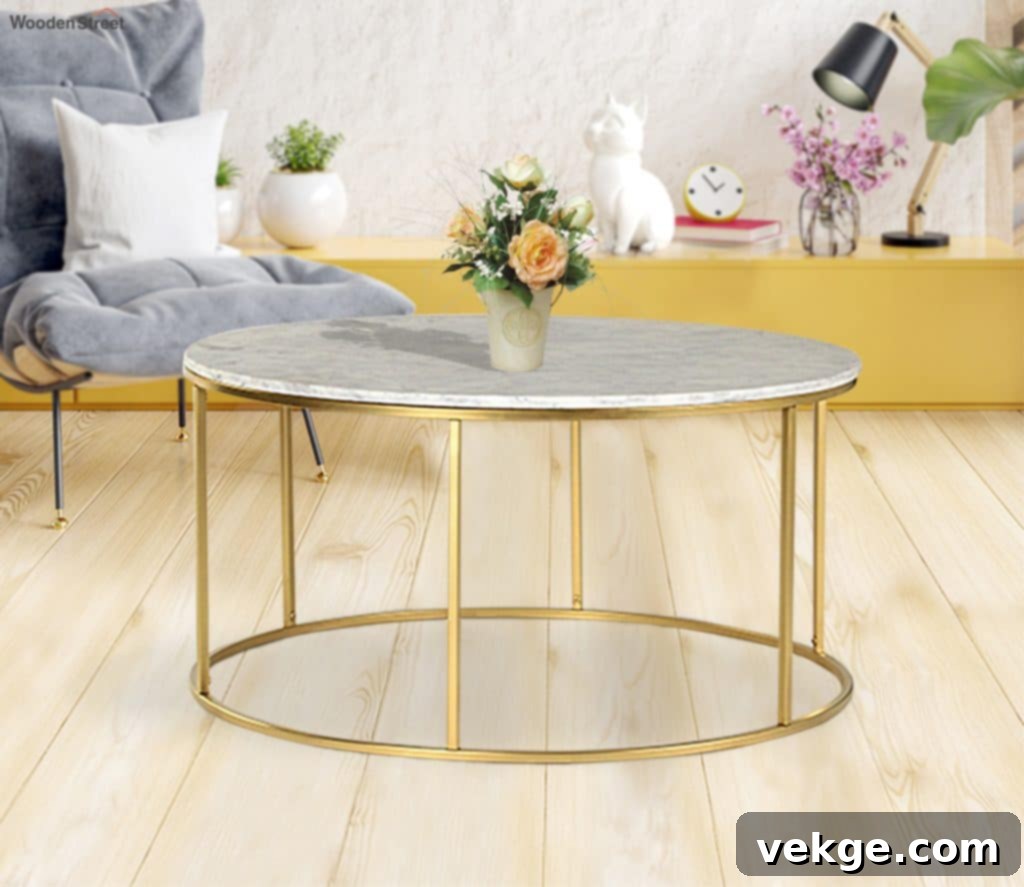
Nesting Coffee Table
Nesting coffee tables are a brilliant solution for small living rooms or spaces that demand flexibility. Typically a set of two or more tables of varying sizes, they are designed to fit neatly underneath each other when not in use, drastically saving floor space. When guests arrive or you need extra surface area, they can be pulled out and used as individual side tables or arranged creatively for a tiered display. This adaptability makes them perfect for those who frequently host gatherings or simply enjoy reconfiguring their living space. They offer both practicality and a dynamic visual interest.
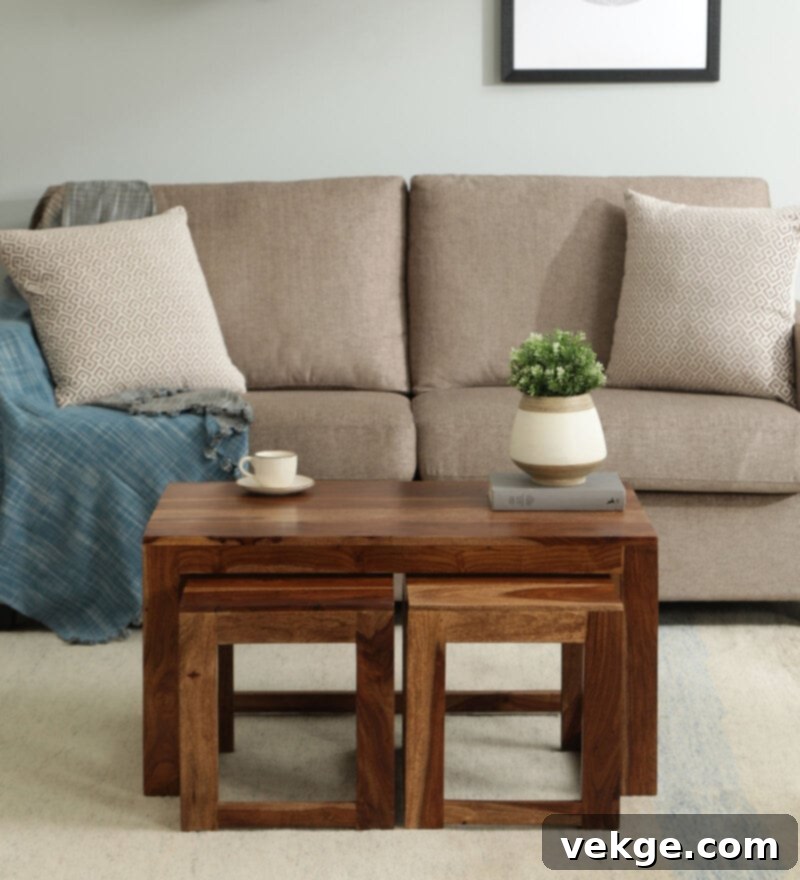
Free-Form Coffee Table
Also known as organic or sculptural coffee tables, free-form designs are characterized by their non-traditional, asymmetrical shapes and often incorporate natural elements like wood, stone, or even unique metalwork. These tables are not just furniture; they are works of art designed to be a conversation starter and a strong focal point. Each piece is often handcrafted, ensuring its uniqueness and adding an unparalleled level of character and elegance to your home decor. Free-form tables are ideal for those looking to infuse their living space with artistic flair and a connection to nature, moving away from conventional geometric forms.

Group of Side Tables (Modular)
Opting for a cluster of smaller side tables instead of a single large coffee table offers incredible flexibility and a dynamic visual appeal. A common arrangement involves three side tables of varying sizes or heights, artfully placed together to create a cohesive yet fluid central piece. This modular approach allows you to spread them out around the room as individual tables when needed for guests, or reconfigure them easily to suit different occasions. This style adds character, encourages creative styling, and is particularly suited for unconventional living room layouts or those who enjoy frequently changing their decor arrangement.
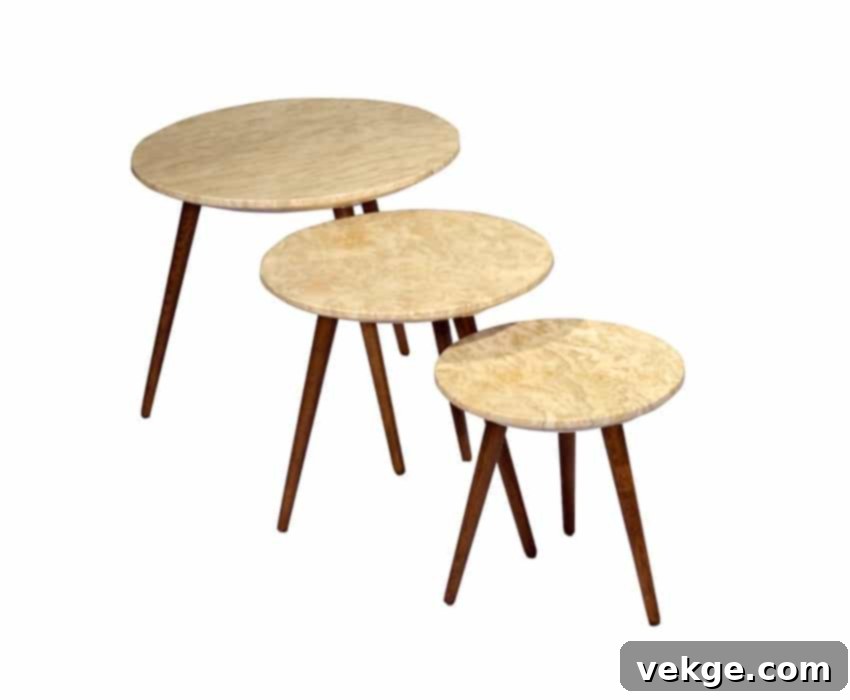
Other Popular Coffee Table Styles:
- Lift-Top Coffee Table: Designed for modern living, these tables feature a top that can be lifted and extended towards you, creating a comfortable surface for working on a laptop, eating a meal, or engaging in hobbies from the comfort of your sofa. Many also offer hidden storage beneath the lift-top.
- Storage Coffee Table (Trunk/Drawer): Beyond ottomans, many coffee tables are specifically designed with drawers, shelves, or hinged tops to provide ample storage for remotes, magazines, blankets, or even board games, helping to maintain a tidy living space.
- Minimalist Coffee Table: Characterized by clean lines, simple forms, and often made from materials like glass, metal, or light wood, minimalist tables focus on functionality and understated elegance, avoiding unnecessary ornamentation.
- Traditional Coffee Table: These tables often feature ornate details, carved legs, darker wood finishes, and classic shapes, reflecting historical design aesthetics and adding a sense of grandeur to a formal living room.
Practical Tips for Choosing the Right Coffee Table
Armed with knowledge about sizes, shapes, materials, and styles, it’s time to put it all together. These practical tips will guide you in making a confident and informed decision.
Measure Your Space Accurately
This cannot be stressed enough: accurate measurements are your best friend. Before you even begin browsing, measure the length and width of the area where the coffee table will sit. Then, measure your sofa and any other prominent furniture. Remember the “two-thirds the length of your sofa” rule and the 18-inch clearance for optimal traffic flow. Also, consider the height relative to your sofa seat (same height or 1-2 inches lower) for ergonomic comfort. Use painter’s tape on the floor to visualize the footprint of different table sizes and shapes.
Consider Your Existing Décor Style
Your coffee table should be an extension of your living room’s overall aesthetic. It should complement, not clash with, your existing furniture and decorative elements. Think about the dominant materials, colors, and design lines already present in your space. For instance:
- For a Parisian Living Room, an elegant marble or glass table with delicate metal accents would be fitting.
- In a Mid-Century Modern Living Room, look for clean lines, tapered legs, and a mix of wood and metal.
- A Farmhouse Living Room would benefit from a rustic wood table, perhaps with a distressed finish or barn-door style elements.
- Coastal Living Rooms often feature light woods, woven textures, or white-washed finishes.
- Scandinavian Coffee Tables are characterized by minimalist design, light wood, and functional simplicity.
- For a Feminine Living Room, consider softer shapes, reflective surfaces, or tables with delicate details.
- A Glam Living Room might feature mirrored, metallic, or high-gloss tables with luxurious finishes.
- Industrial Living Rooms call for raw materials like metal and concrete, or rough-hewn wood.
- Boho Coffee Tables often incorporate natural wood, woven elements, or eclectic, global-inspired designs.
The goal is to create a cohesive look, whether through matching elements or by introducing a well-chosen contrasting piece that adds visual interest without disrupting the harmony.
Consider Your Lifestyle Needs and Functionality
Your coffee table isn’t just for show; it should serve your daily life. Think about how you and your household will primarily use it:
- Families with Children or Pets: Opt for durable materials like solid wood or metal. Round or oval shapes are safer as they eliminate sharp corners, reducing the risk of accidental bumps. Materials that are easy to clean are also a plus.
- Entertaining Guests: If you frequently host, a larger surface area is beneficial for serving food and drinks. Consider a multi-functional ottoman or a nesting table set that can be expanded.
- Working or Eating from the Sofa: A lift-top coffee table can be a game-changer, bringing the surface up to a comfortable height for a laptop or a meal.
- Storage Solutions: If clutter is a concern, prioritize tables with built-in drawers, shelves, or hidden compartments to keep remotes, magazines, and other essentials neatly tucked away.
- Displaying Decor: If you enjoy styling your table with books, plants, and decorative objects, ensure it has a stable, spacious surface that highlights your chosen items.
Budget Considerations
Finally, set a realistic budget. Coffee table prices vary widely depending on material, craftsmanship, brand, and size. While it’s tempting to opt for the cheapest option, remember that a good coffee table is an investment in your living space. Consider the long-term durability and how well it fits your aesthetic goals. Sometimes, spending a little more upfront for a quality piece will save you money and headaches in the long run.
Conclusion
Choosing the perfect coffee table for your living room doesn’t have to be a daunting task. By systematically considering key factors like size, shape, material, and color, and by carefully evaluating different styles and practical needs, you can confidently select a piece that truly elevates your home. The coffee table you choose is a reflection of your personality and a cornerstone of your living space, offering both a functional surface and a significant decorative statement.
Remember to measure your space accurately, align your choice with your existing decor, and prioritize the functionality that best suits your lifestyle. With these insights, you’re well-equipped to find a coffee table that not only meets all your requirements but also beautifully completes your living room, making it a more inviting, stylish, and enjoyable place to relax and entertain.
